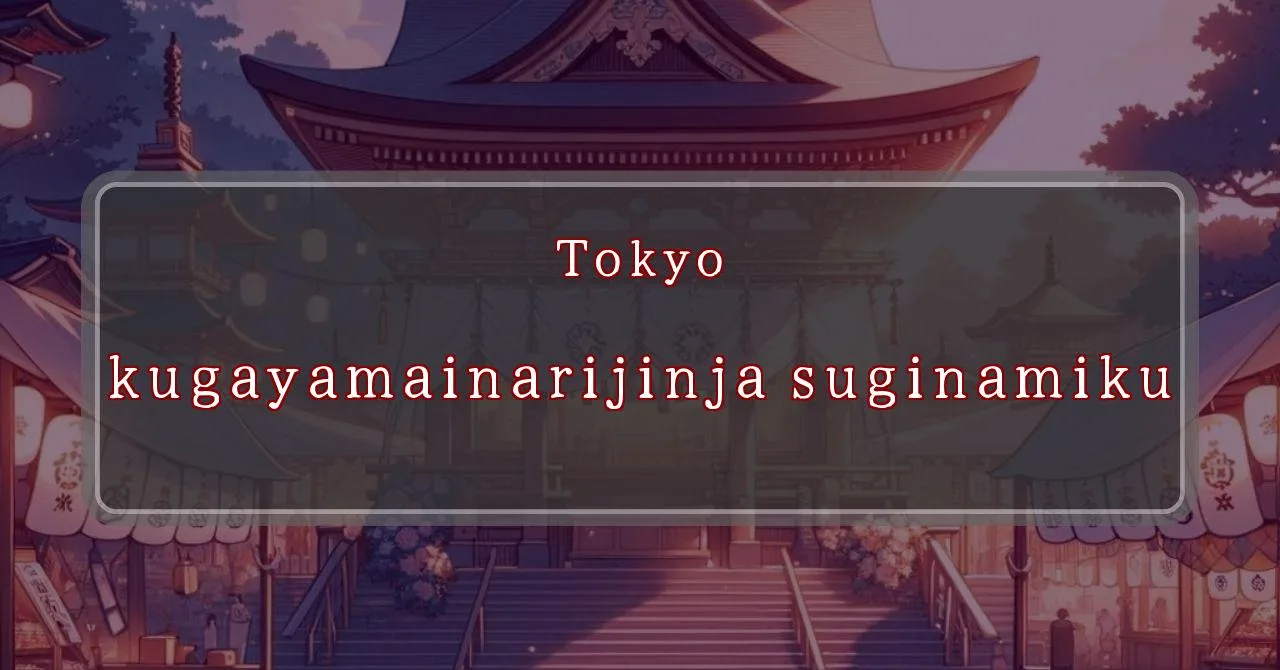Enchanting melodies and vibrant hues at Kugayama Inari Shrine
Shinto shrine located in Suginami Ward, Tokyo, Japan. It is dedicated to the deity Ukemochi-no-Mikoto, the god of food and agriculture.
- Address: 3-37-14 Kugayama, Suginami-ku, Tokyo 168-0073
- Phone Number: 03-3329-0837
- Access: 5-minute walk from Kugayama Station on the Keio Inokashira Line
- Festival Days: July 24th (Summer Festival), First Sunday of October (Autumn Festival), 2024
Main Events and Attractions of the Festival
The Kugayama Inari Shrine Festival is a vibrant and lively event that attracts many visitors each year. The main events and attractions of the festival include:
湯の花神楽 (Yunohana Kagura)
This is a unique ritual that is performed at the shrine on the day of the summer festival. During the ritual, a large cauldron is filled with hot water, and a priest uses a small bamboo branch to sprinkle the water around the shrine. This ritual is believed to bring good luck and ward off evil spirits.
神輿渡御 (Mikoshi Togyo)
This is a procession in which a portable shrine (mikoshi) is carried through the streets of the neighborhood. The mikoshi is believed to be inhabited by the deity of the shrine, and the procession is a way of showing respect to the deity and asking for blessings.
屋台 (Yatai)
During the festival, many food stalls and game booths are set up in the shrine grounds. Visitors can enjoy a variety of traditional Japanese foods, such as yakisoba, takoyaki, and cotton candy. There are also games such as ring toss and goldfish scooping.
奉納演芸 (Honou Engei)
On the day of the autumn festival, there are various performances held at the shrine, such as traditional Japanese music and dance. These performances are a way to entertain the deity of the shrine and to show gratitude for the blessings that have been received.
Blessings and Deities
Kugayama Inari Shrine is dedicated to Ukemochi-no-Mikoto, the deity of food and agriculture. Ukemochi-no-Mikoto is said to have created the five grains (rice, wheat, barley, millet, and beans) and is also associated with fertility and abundance. Worshipping Ukemochi-no-Mikoto is believed to bring blessings such as a bountiful harvest, good health, and prosperity.
Origin and History
The exact origins of Kugayama Inari Shrine are unknown, but it is believed to have been founded in the early 17th century. The shrine was originally located in a different part of Suginami Ward, but it was moved to its current location in 1941. Kugayama Inari Shrine became an independent shrine in 1944 and has been a popular place of worship ever since.
Tips and Notes for Visitors
- The Kugayama Inari Shrine Festival is held twice a year, once in July and once in October. The summer festival is held on July 24th, and the autumn festival is held on the first Sunday of October.
- The shrine is open every day from 9:00 AM to 5:00 PM. Admission is free.
- There is a small parking lot available for visitors. However, it is recommended to use public transportation, as the shrine is located near a train station.
- The shrine is a popular destination for weddings and other ceremonies. If you are planning to visit the shrine for a special occasion, it is best to make a reservation in advance.
Parking Information
There is a small parking lot available for visitors to Kugayama Inari Shrine. However, it is recommended to use public transportation, as the shrine is located near a train station. The nearest station is Kugayama Station on the Keio Inokashira Line.
Popular Stalls and Food Carts in Recent Years
| Type of Stall | Description |
|---|---|
| Takoyaki | A staple at Japanese festivals. Characterized by a crispy outside and a creamy inside. |
| Jaga Butter | A simple yet popular snack of hot potatoes lavishly topped with melted butter. |
| Baby Castella | Small castella cakes, sweet and fluffy treats enjoyed by children and adults alike. |
| Grilled Ayu with Salt | Fresh ayu fish grilled whole with salt, a savory taste of Japanese summer. |
| Shaapin | A unique gourmet item influenced by foreign cuisine, with a chewy skin wrapping the filling. |
| Okonomiyaki | A Japanese grilled dish where you often choose your own ingredients for a personalized flavor. |
| Cotton Candy | A fluffy, sweet snack that’s extremely popular with children. |
| Chocolate Banana | A banana coated in chocolate, a fun and visually appealing dessert. |
| Kushiyaki | Various types of ingredients skewered and grilled, an easy-to-enjoy snack. |
| Yakisoba | Fried noodles mixed with a special sauce, a fast food favorite in Japan. |



